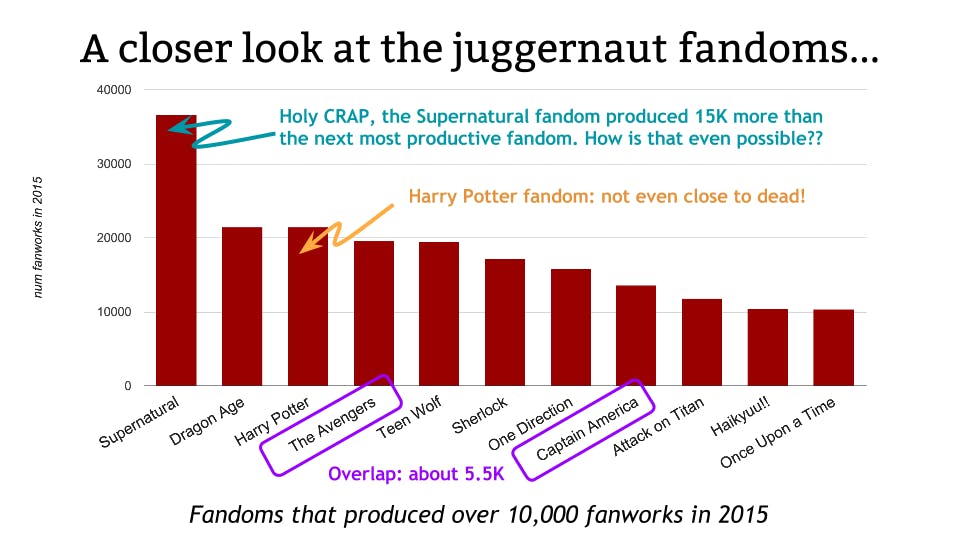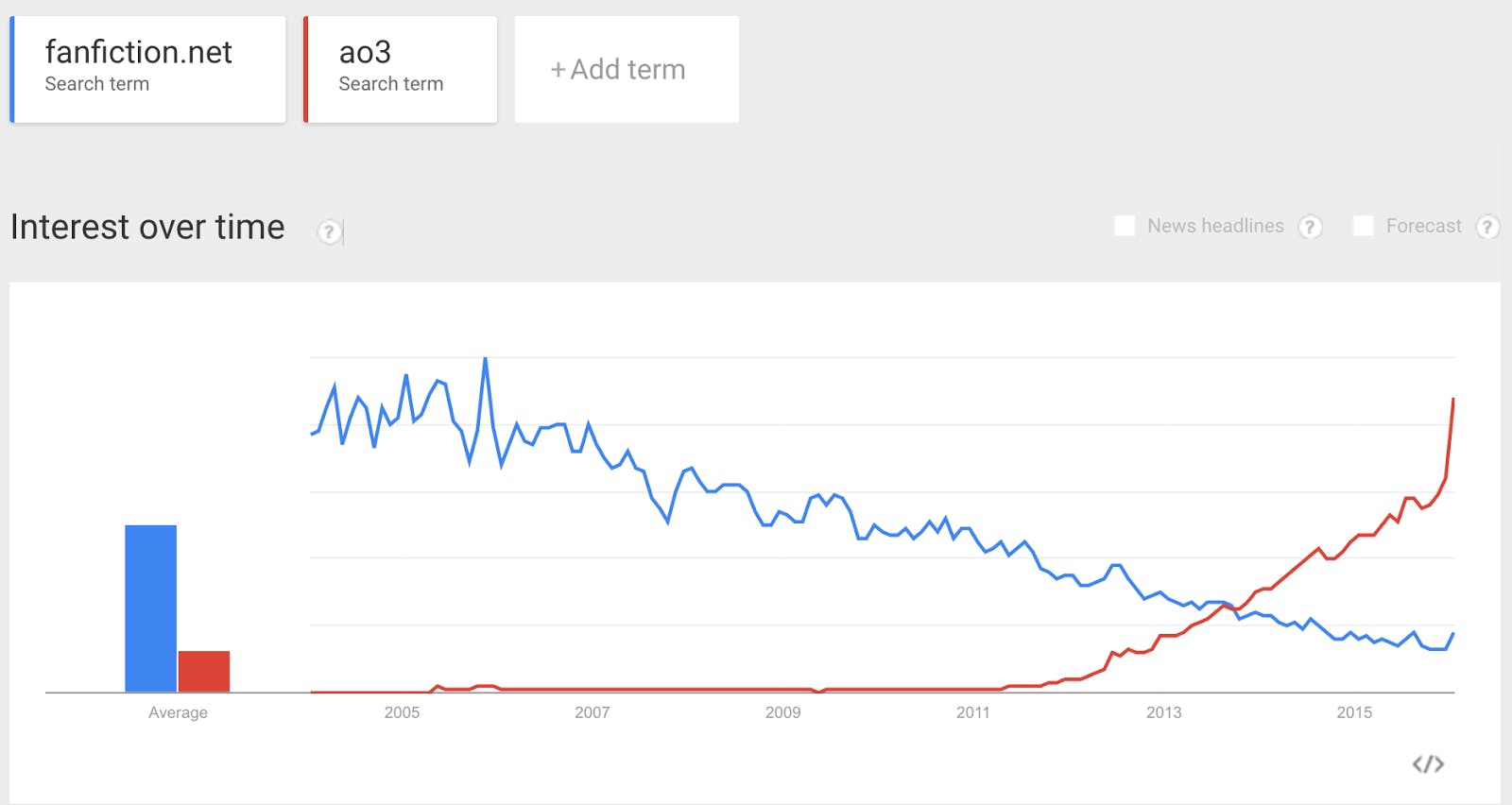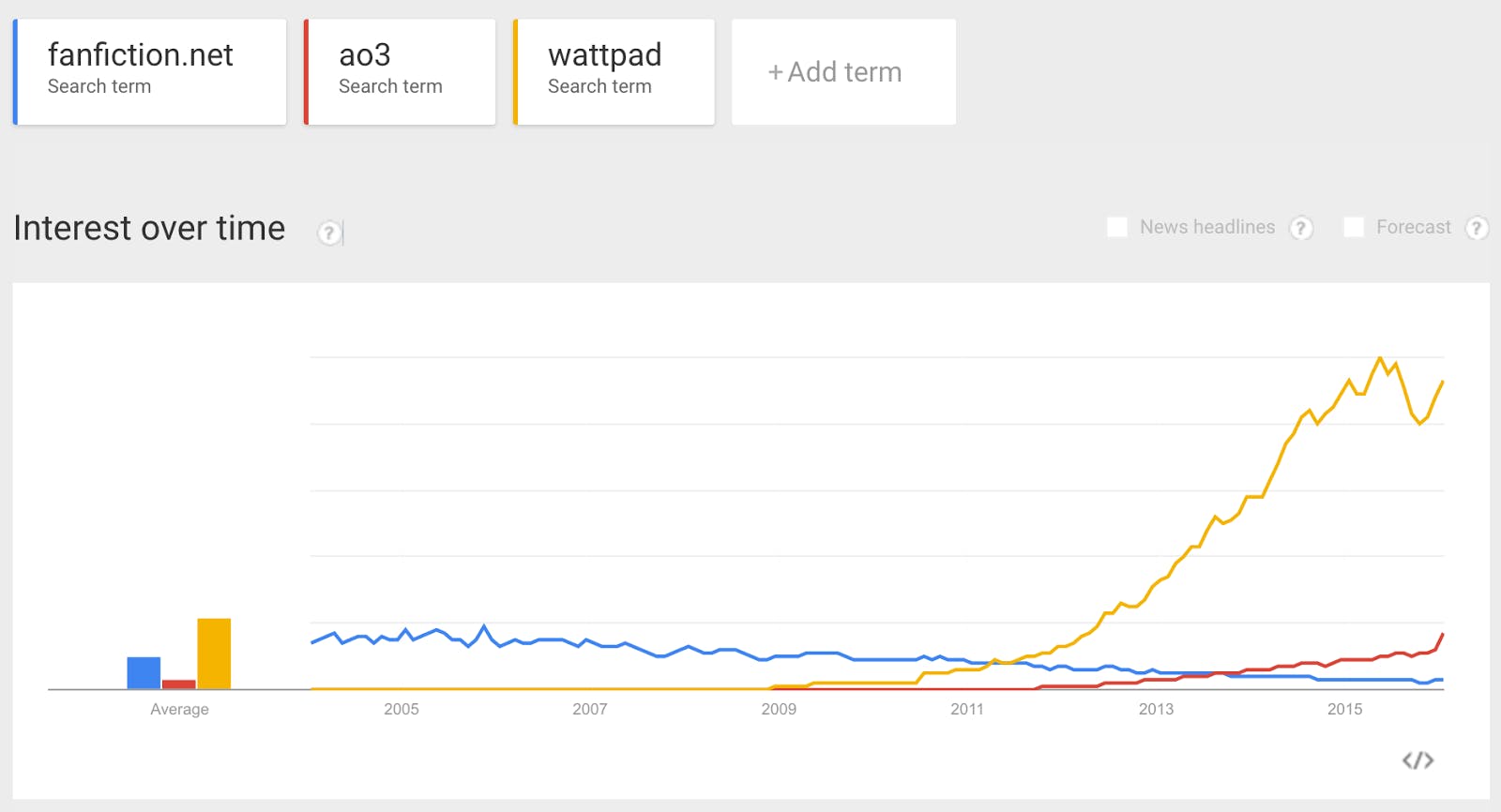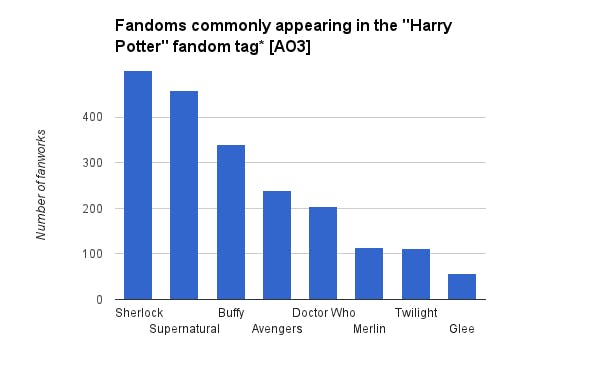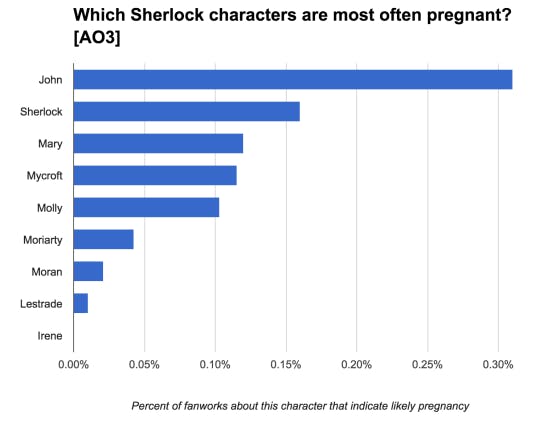How many people are in your fandom? If you’re involved in sports, gaming, and other more mainstream fan activities, you probably have plenty of ways to measure fandom activity through game attendance, merchandise sales, YouTube views, and other noticeable numbers. But in female-dominated online fandoms, fans often occupy their own spaces and have less direct interaction with the things they’re enthusiastic about.
It’s never been easy to visualize the often-hidden practice of fanfiction and other online fandom activities. But more and more, fans are changing that through the use of statistical analysis. One of the leaders of this trend is Tumblr user destinationtoast, who frequently posts fandom analytics on her Tumblr Toasty Stats. Toasty recently did a much-shared survey of what 2015 looked like in fandom from multiple perspectives. As even a cursory look at fandom statistics reveals, fandom communities differ vastly from platform to platform, and even fandom to fandom.
On the fanfiction archive Archive of Our Own (AO3), the dominant fandoms are nearly all ones in which male/male slash relationships are extremely popular. Meanwhile, on Wattpad, the mighty One Direction dwarfs all other fandoms, while the older and longstanding Fanfiction.net is still dominated by equally longstanding fandoms like Naruto and Harry Potter.
A Californian in her late 30s, Toasty told the Daily Dot in an email that she studied psychology and linguistics in college and had some academic and professional background in statistics.
“Media fans used to hide in the shadows.”
“I learned a bunch of statistics by running experiments about how people used language and analyzing data,” she said. “I also took computer science and picked up some coding skills, which helped me to more quickly gather data off of websites like AO3. Later, I worked in the tech industry, sometimes doing some data analysis as well.”
Toasty told us she tends to make graphs about everything in her life and that, “I think pretty analytically, in general… So it was a natural fit when I came into fandom.” Most of her work on fandom culture has been introspective, focused on Sherlock fandom, along with various fandom trends that spin out of the primarily slash-centric fan cultures of AO3, Tumblr, and LiveJournal.
We wanted to pick destinationtoast’s brain about the way modern fandom looks when viewed through a few select graphs. She helpfully provided her wealth of thoughts—and a few charts.
Do you think there’s something about female-dominated, fanworks-based online fandom that makes numerical representation and visibility a difficult topic?
That’s not so much my area of expertise, so I’m speculating here based on what I know of the history of fandom. But trying to assess the size of transformative fandom (fandoms that create fanworks), as compared to, say traditional sports-based fandom, does present an interesting challenge.
It seems like media fans used to hide in the shadows more, media fandom being seen as nerdy rather than something you’d admit to—but now things like Comic-Con and standing in line for sci-fi movie premieres have become much more mainstream. Also, many fanworks used to be more hidden due to worries about copyright.
In other words, for a long time, fandom was to some extent deliberately obfuscating itself. I suspect that may still be true in countries like China, where writing slash fic can get you in trouble.
“My friends [don’t know] what it means that Larry Stylinson is bigger than Johnlock.”
On top of all that, for a long time fanworks were splintered into separate fandom-specific or ship-specific sites, and before that, zines [fan-distributed collections of fanfic and fanart]. That made it particularly difficult to get a sense of the size of fandom as a whole. Even now, it’s hard to estimate the total or relative sizes of fandoms on a site like LiveJournal, where content is divided into individual blogs and communities, and you can’t look at tags or topics across all of them.
In contrast, something like sports fandom has long been out in the open, and relatively unified into a few leagues. Plus, corporations have been trying to profit off the fans, so they’re pretty good at sizing the market.
But it would be possible now—not even necessarily all that hard—to get a sense of the number of active users on the main fanfiction sites. They don’t publish their monthly active user stats, but I think you could look at the number of accounts on AO3, FFN [Fanfiction.net], and Wattpad, and then look at a random sample of authors to see how many of them have published recently, to arrive at an estimate of how many users are active on these platforms right now. That wouldn’t answer how many betas [fans who edit and assist other fans] there are, or how many authors and artists and creators are active on all the many other homes of fandom and fanworks online. But it would be a start.
I haven’t done it, though. Although now I’m kind of tempted…
Do you think fandom statistics help visualize fanworks-based fandom and the people making it to the mainstream, or is it largely just something we (fans) do for ourselves?
“Generally, it’s just lovely if people are using data when discussing fandom.”
There has been an increase in attention to fandom stats from the media—very visibly last year’s Wattpad article in Vulture (here’s my added insight based on my own work), but also in publications such as the Daily Dot, The Toast, and Huffington Post, which have covered my fandom stats and other fans’.
This seems to be a collision of two media trends: 1) more data science in the media for a wide variety of topics (with the rise in popularity of sites like Five Thirty Eight), and 2) more mainstream media attention to fanfiction, cosplay, fanart, shipping, and other aspects of fandom that used to hide in the shadows.
But at the level of detail that I—and others—tend to get into with our analyses, I think the results are mostly of interest specifically to people deeply involved in fandom. What’s the deal with Omegaverse? How does shipping vary across fanfic platforms? Those questions are not very meaningful outside of fandom. I share some of my fandom stats work sometimes with friends outside fandom, but they have no context at all to understand what it means that Larry Stylinson was a bit bigger than Johnlock on AO3 in 2015.
The Archive of Our Own is hugely important to fandom culture but still seems relatively unknown outside of Tumblr and fanfic-based fandom. You’ve said you focus your stats there because it’s easiest to measure, but are there other cultural reasons that AO3 seems to get the lion’s share of fandom statistics love?
AO3 is actually very popular and growing in popularity, in part at the expense of FanFiction.net (although both platforms are still quite active). You can see that the number of fandoms producing over 2,500 works in 2015 was higher on AO3 than Fanfiction.net (54 vs. 41), whereas the opposite was true several years ago:
However, Wattpad is possibly bigger than both platforms in terms of fanworks produced and reader interest—though it’s incredibly difficult to tell with any precision, because they’re far less transparent about their numbers, and because they also have other types of fiction besides fanfic.
All of which is to say, AO3 is not only way easier to get numbers for, it is also quite popular within fandom, which makes it a good place to start with fandom stats. But other platforms should not be ignored—especially because there are such interestingly different results on each platform!
“I hope fans find creative ways to analyze even more broadly.”
There are a few other reasons why AO3 might get so much love. I personally have a bias to study AO3 because it’s where I and all my fandoms hang out. And there are only a handful of other fandom stats geeks currently—many of whom’ve been inspired by each other and hang out in similarly AO3-heavy circles. I think many people are drawn first to analyze whichever parts of fandom they’re most familiar with.
Additionally, Wattpad users tend to skew much younger than AO3 users. There are definitely tons of exceptions, of course! But most people doing fandom stats tend to have taken college classes or had professional experience involving data and spreadsheets—so they’re older than most Wattpad users. Thus they may be more likely to be on AO3 than Wattpad.
That said, AO3 needn’t get all the love. I’ve branched out to look at other fanfic platforms, and to do some preliminary looks at platforms like Deviantart. And I know a few other people who’ve done fandom stats or are planning to do fandom stats involving Fanfiction.net, specific LiveJournal communities or kinkmemes, subreddits, gaming forums, and other online platforms. And while text-based and tagged fanworks are some of the easiest to analyze, I hope other fans will find creative ways to analyze an even broader set of fanworks in the future!
What are some statistics you’ve found as you’ve dug into the community that have surprised you?
I was surprised how much fanfic is AU [Alternate Universe]—when I last looked, 14 percent of AO3 works were AU. It hadn’t occurred to me when I first joined fandom that so many fans of BBC Sherlock would want to read about the show’s characters as high school students. Or as Harry Potter students!
I was initially surprised how much of AO3 [fanfiction] is male/male—and that the ratio probably isn’t as strong across other platforms. FFN and Wattpad both have a lot more [hetero] ships (as discussed in the Year in Fandom). Fandom has a lot of thoughtful discussions about the many reasons for the popularity of dudeslash. I’ve started to examine a single factor in more depth: the source media. And I’ve again been surprised by just how male-dominated TV is—even some of my favorite female-led TV shows. But I think the relationship between gender ratios in source media and in fandom is complex and fascinating, and I’m working on further stats on this topic.
“Fans are creative and more visibly active and prolific than ever”
From an author’s perspective—as someone who posts fanfic to AO3 and FFN—I was surprised to find that the majority of fanworks don’t receive any comments.
I was surprised by the longevity of a lot of fandoms. In my Year in Fandom stats, there’s Supernatural, still going incredibly strong a dozen years in—but also, there’s Harry Potter, and Buffy the Vampire Slayer, and Merlin, and various other properties that haven’t had new infusions of canon in some time. It’s impressive to see so many fictional worlds and characters that inspire long-term fandoms.
I was surprised that what’s common varies so much between fandoms, and even between ships. AO3 is most heavily M/M-focused, as discussed, and has only recently gained momentum in gaming and anime/manga fandoms. FFN has more of a balance of [hetero] ships and slash, and also more cartoon fandoms and G-rated fandoms (probably in part because of their policies banning explicit fic and RPF—real person fiction). Wattpad is extremely focused on RPF around boy bands and internet celebrities. The majority of the popular stories there seem to be romances between celebrities and original female characters. And the reading, writing, and feedback practices are very different on each platform.
A lot of my fandom friends had never even heard of Wattpad until I started posting stats about it—but a lot of teens have probably never used AO3. And most of my fandom friends are on Tumblr, but I know other fandoms like [One Direction] are very active on Twitter. So depending which fandom you’re in—and even which pairing you ship within that fandom—your fandom haunts and habits, and what you consider to be “normal,” will vary a lot.
Have you garnered interest in your stats from any unexpected or notable places?
I’ve been a little surprised by the number of students who’ve wanted to use my stats in their dissertations—I didn’t realize how many people were studying fandom in grad school these days. That’s a topic that I obviously approve of gathering data on—though it also makes me worry a little, because I know how grim the job market is for academics right now, especially in humanities and social sciences.
I’ve also been amused and pleased by the number of lawyers, librarians, and other professionals who’ve wanted to cite them as part of introductions to fanfiction for their own fields—but generally, it’s just lovely if people are using data when discussing fandom.
What are some common misconceptions about fanworks-based fandom that you and other fans have been able to debunk through statistics?
Despite its reputation, most fanfic is not porn. (Though explicit fanfic is the most popular.)
Despite fandoms’ reputation for being mostly straight women, in the largest surveys done so far, including surveys done of M/M slash fans, that doesn’t seem to be true. (This is almost certainly not a representative sample of fandom, but it does at least indicate that there are many queer-identified fans.)
Most of the other myths I’ve busted have been specific to the Sherlock fandom. For example, the character who is depicted as non-canonically pregnant in fic the most often is not Molly Hooper, but John Watson!
Can you talk about any fandom trends you anticipate seeing in 2016 based on the data so far?
I expect both the Star Wars and Hamilton fandoms to be very active in 2016 on AO3—and Star Wars will probably be popular everywhere.
The fandoms that grew rapidly from small to very large in 2015 will likely continue to be very active—Dragon Age, The 100, Haiky?!! among them.
Juggernaut fandoms that show no signs of going anywhere include Supernatural, Sherlock, Harry Potter, Marvel, Teen Wolf, One Direction, and—as of more recently—Once Upon a Time.
I feel cautiously optimistic by the rapid increase in popularity of a bunch of femslash ships in 2015, and fandoms with female main characters. I’m hoping that femslash shippers will have a good year with more new fanworks to read than ever before.
How do fans respond to your infographics?
Every time I post something like my Year in Fandom stats, a lot of people are sad or worried because their fave didn’t make the list. Which in turn makes me sad—I definitely don’t intend to bring angst when I share stats! So I want to make sure people realize: If your fave is not on a list, it doesn’t mean your fandom or ship is dying. As I mentioned before, there are many fandoms with very impressive longevity indeed!
Rather, fans were so amazingly creative and productive that I ended up needing to set the bar for inclusion astoundingly high, which I did for my own sake—because it takes me quite a while to gather and analyze the data, so I stop before I’ve covered nearly all the fandoms. But there were a ton of very active fandoms—e.g., Mad Max—that produced oodles of stuff in 2015 and didn’t pass the particular arbitrary threshold I set for these visualizations. Take heart! It doesn’t mean anything negative about your fandom or ship. It frequently just indicates the limitations of this fandom statistician.
Illustration by twosugars16/deviantART


